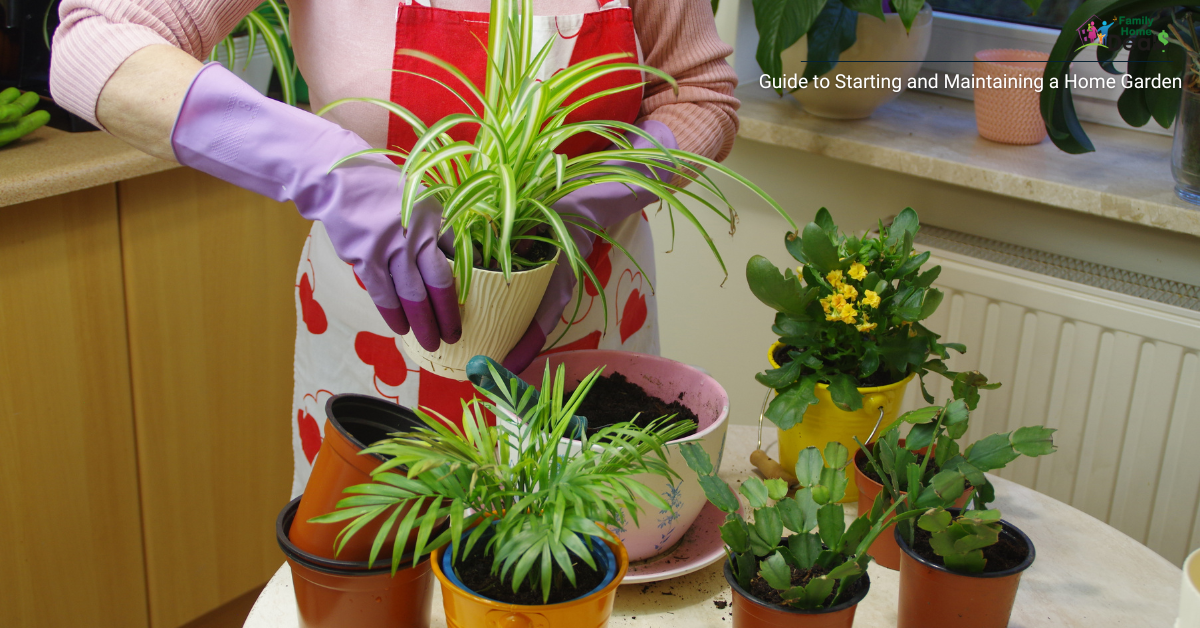
Imagine stepping outside your door and picking fresh herbs for your dinner or plucking ripe tomatoes right from your backyard. Starting a home garden can transform this vision into reality, offering not just a source of fresh produce but also a relaxing and fulfilling hobby. Whether you’re a seasoned gardener or a newbie looking to dip your toes into the world of gardening, creating and maintaining a home garden is both exciting and rewarding. This comprehensive guide will walk you through the essential steps to start a home garden and provide you with practical tips for keeping it thriving throughout the seasons.
Gardening can seem overwhelming with all the choices and tasks involved, but don’t let that deter you. From selecting the right plants to understanding the basics of soil and water management, we’ll break down each step in a simple and engaging way. By the end of this article, you’ll have the confidence to start a home garden and the know-how to keep it growing strong. So, roll up your sleeves and get ready to dig into the world of home gardening!
Steps to Start a Home Garden
1. Choose the Right Location
Choosing the right location for your garden is crucial for its success. Here’s what to consider:
- Sunlight: Most vegetables and herbs need at least 6-8 hours of direct sunlight each day to thrive. Observe your yard throughout the day to determine which areas receive the most sun. Keep in mind that the amount of sunlight can vary with the seasons, so choose a spot that will offer ample light year-round.
- Accessibility: Opt for a location that’s easy to access for routine tasks such as watering, weeding, and harvesting. A convenient spot will make garden maintenance less of a chore and ensure you’re more likely to keep up with regular care.
- Soil Quality: Good soil is essential for healthy plants. Avoid areas with poor drainage or heavy clay, as these conditions can lead to root rot and other problems. Ideally, look for well-draining soil rich in organic matter. You can also improve soil quality by incorporating compost or other organic materials.
2. Decide What to Grow
Deciding what to plant is a crucial step in starting a home garden. Here’s how to make your selection:
- Climate: Choose plants that are well-suited to your local climate. Understanding your USDA Hardiness Zone can help you select plants that will thrive in your region. For example, if you live in a cooler climate, consider growing cold-hardy vegetables like kale and carrots.
- Space: Evaluate the amount of space you have available. If you’re limited on space, consider growing compact plants or using container gardening methods. Vertical gardening can also maximize space by using trellises and hanging planters.
- Preferences: Grow the vegetables, herbs, and fruits you enjoy eating. This not only makes your garden more enjoyable but also ensures you’ll make the most of your harvest. Consider starting with easy-to-grow options like tomatoes, lettuce, and herbs if you’re new to gardening.
3. Plan Your Garden Layout
Planning your garden layout helps ensure a successful and manageable garden. Follow these steps:
- Garden Size: If you’re new to gardening, start small. A modest garden is easier to manage and will help you gain experience. As you become more confident, you can expand your garden space.
- Plant Spacing: Proper spacing between plants is essential for healthy growth. Crowded plants compete for resources and may be more prone to disease. Refer to seed packets or plant labels for specific spacing recommendations.
- Companion Planting: Consider using companion planting techniques to boost plant growth and deter pests. For example, planting basil near tomatoes can improve their flavor and help repel certain insects.
4. Prepare the Soil
Healthy soil is the foundation of a successful garden. Follow these steps to prepare your soil:
- Test the Soil: A soil test will provide valuable information about pH levels and nutrient content. You can purchase a soil test kit from a garden center or send a sample to a local extension service for analysis. This information will guide you in making any necessary soil amendments.
- Improve the Soil: Enrich your soil by adding compost or organic matter. This helps improve soil structure, fertility, and drainage. Organic matter also provides essential nutrients that plants need to thrive.
- Tilling: Loosen the soil to a depth of about 12 inches to help roots penetrate and grow effectively. Use a garden fork or tiller to break up compacted soil and mix in compost.
5. Choose Your Gardening Method
Selecting the right gardening method can affect your garden’s success. Here are a few methods to consider:
- Traditional Garden Beds: These are either raised beds or ground-level plots filled with soil. Raised beds can improve drainage and soil quality, while ground-level beds are typically easier to set up.
- Container Gardening: Ideal for small spaces or urban environments, container gardening involves growing plants in pots or other containers. This method allows for greater control over soil conditions and can be used on patios, balconies, or windowsills.
- Vertical Gardening: This method makes use of vertical space to grow plants. Trellises, hanging baskets, and wall-mounted planters are great for growing climbing plants like beans and cucumbers.
6. Plant Your Seeds or Seedlings
With your garden site prepared, it’s time to plant. Here are some tips for successful planting:
- Read Seed Packets: Seed packets provide important information on planting depth, spacing, and germination times. Follow these instructions to ensure optimal growth conditions for your plants.
- Transplanting: When using seedlings, plant them at the same depth they were in their pots. Avoid burying the stems too deeply, as this can cause rot.
- Watering: Water your plants thoroughly after planting to help them settle in. Keep the soil consistently moist but not waterlogged, especially during the initial growth phase.
How to Maintain Your Home Garden
1. Watering Wisely
Proper watering is key to a healthy garden. Here’s how to do it:
- Consistent Schedule: Water your garden consistently. Most plants need about 1 inch of water per week, but this can vary based on the weather and soil type. Consider using a rain gauge to monitor rainfall and adjust your watering schedule accordingly.
- Early Morning: Water in the early morning to reduce evaporation and disease risk. This allows plants to absorb moisture before the heat of the day, ensuring they stay hydrated during the hotter hours. If you can’t water in the morning, early evening is the next best option.
- Soil Check: Stick your finger into the soil. If it’s dry an inch below the surface, it’s time to water. Alternatively, use a soil moisture meter for a more accurate reading. This tool helps prevent over-watering or under-watering, promoting healthier root growth.
2. Fertilize Regularly
Fertilizing provides essential nutrients for plant growth. Consider these points:
- Type of Fertilizer: Use balanced fertilizers (like 10-10-10) or specialized ones based on your plants’ needs. For example, leafy greens benefit from higher nitrogen content, while flowering plants thrive with more phosphorus.
- Application: Follow the instructions on the fertilizer package. Over-fertilizing can harm plants, causing them to become leggy or susceptible to disease. If using granulated fertilizers, be sure to water after application to help the nutrients penetrate the soil.
- Organic Options: Consider using compost or organic fertilizers for a more natural approach. Compost not only nourishes plants but also improves soil structure. Worm castings and fish emulsion are excellent organic options that provide essential nutrients without the risk of chemical buildup.
3. Control Pests and Diseases
Keeping pests and diseases at bay is crucial. Here’s how to manage them:
- Regular Inspection: Check plants regularly for signs of pests or diseases. Look for unusual discoloration, wilting, or holes in leaves. Early detection is key to effective management.
- Natural Remedies: Use organic pest control methods like neem oil or insecticidal soap, which are less harmful to beneficial insects and the environment. Introduce beneficial insects like ladybugs and lacewings, which naturally prey on common pests.
- Proper Hygiene: Keep your garden clean and remove any dead or diseased plants. Regularly clean tools and pots to prevent the spread of pathogens. Disinfecting pruning shears before and after use can also help reduce disease transmission.
4. Prune and Support Plants
Pruning and supporting your plants helps them grow better. Follow these tips:
- Pruning: Remove dead or overgrown branches to encourage healthy growth and improve air circulation. Use sharp, clean tools to make clean cuts that heal quickly. For flowering plants, deadheading (removing spent flowers) encourages more blooms and prevents the plant from going to seed too early.
- Staking: Use stakes or cages for plants that need support, like tomatoes and peppers. Install supports early in the growing season to avoid disturbing roots later. For climbing plants like beans or peas, consider using trellises, which can also save space and improve air circulation.
5. Mulch and Weed Control
Mulching and weeding are essential for garden health. Here’s how:
- Mulching: Apply a layer of mulch (2-3 inches) around plants to retain moisture and suppress weeds. Organic mulches, such as straw, wood chips, or shredded leaves, decompose over time and enrich the soil.
- Weeding: Regularly remove weeds, which compete with your plants for nutrients and water. Pull weeds when they’re small and before they go to seed to prevent them from spreading. Using a hoe or cultivator can help uproot weeds without disturbing the surrounding plants. Consider planting ground cover crops to suppress weeds and improve soil health during the off-season.
Conclusion
Starting a home garden is a fulfilling endeavor that brings numerous benefits, from fresh produce to a relaxing hobby. By carefully selecting your garden location, choosing the right plants, and following a well-thought-out maintenance routine, you’ll set yourself up for success. Remember, gardening is a learning process. Don’t be discouraged by initial challenges. With patience and persistence, you’ll gain the experience needed to cultivate a thriving garden that you can enjoy year after year.
Maintaining a garden involves ongoing care, but the rewards are well worth the effort. Regular watering, fertilizing, pest control, and weeding will keep your plants healthy and productive. As you become more familiar with your garden’s needs, you’ll find it easier to manage and even experiment with new techniques. So, embrace the journey of gardening and watch your home garden flourish into a lush and vibrant space.
Trivago will do the searching. You do the saving.
 Trivago, a leading global hotel search platform, simplifies the process of finding the perfect accommodation for travelers worldwide. With its user-friendly interface and comprehensive database of hotels, Trivago enables users to compare prices from various booking sites, ensuring they secure the best deal for their desired stay. Visit trivago.com for a seamless booking experience, helping travelers make informed decisions and embark on memorable journeys with confidence.
Trivago, a leading global hotel search platform, simplifies the process of finding the perfect accommodation for travelers worldwide. With its user-friendly interface and comprehensive database of hotels, Trivago enables users to compare prices from various booking sites, ensuring they secure the best deal for their desired stay. Visit trivago.com for a seamless booking experience, helping travelers make informed decisions and embark on memorable journeys with confidence.



